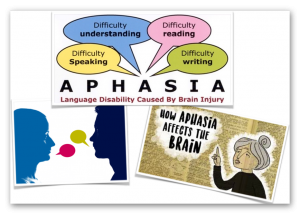The video I would like to review is Aphasia: the disorder that makes you lose your words created by Susan Wortman-Jutt and published by Ted-Ed videos. This video speaks about a little-known language disorder named Aphasia. It can impair all aspects of communication. Anyone can suffer with Aphasia, including children. It is usually caused by a stroke or brain injury with damage to one or more parts of the brain that deal with language.
 People with Aphasia do not lose their intelligence. They know what they want to say, but they express themselves in incorrect ways. There are two types of Aphasia: expressive Aphasia (non-fluent) and receptive Aphasia (fluent). People with expressive Aphasia know what to say but they aren’t able to expose it to others.
People with Aphasia do not lose their intelligence. They know what they want to say, but they express themselves in incorrect ways. There are two types of Aphasia: expressive Aphasia (non-fluent) and receptive Aphasia (fluent). People with expressive Aphasia know what to say but they aren’t able to expose it to others.
On the other hand, people affected by receptive Aphasia hear what the interlocutor says but they have difficulty comprehending the speech of others. The human brain has two hemispheres. In 1861, the physician Paul Broca discovered that in most people, the left hemisphere governs language.
Thanks to the post–mortem study of a patient’s brain, he discovered a large lesion in the left hemisphere now known as Broca’s area, which is responsible in part for naming objects and coordinating the muscles involved in speech. Behind this area is the Wernicke’s area: responsible for understanding the language.
Fortunately there are other areas that support these two language centres, because Aphasia is caused by injury to one or both of these specialized language areas.
Treatment for someone with aphasia depends on factors such as: age, cause of brain injury, type of aphasia and the position and the size of the brain’s lesion.
I would recommend this video to everyone because everybody should know what Aphasia is. Despite Aphasia is widespread, nobody knows it.
It is very important to know this disease, because if everyone knows it, everyone can help aphasia’s sufferers. In this way aphasia’s sufferers will not be isolated and they will be able to improve themselves.
Elvira Bellicini, 4 A Scientifico



